Fuji Electric OPC-G1-ETH User manual

August 5, 2011
Part #10821 © 2011 Fuji Electric
OPC-G1-ETH
Multiprotocol Ethernet Interface
Thank you for purchasing the OPC-G1-ETH Multiprotocol Ethernet Interface.
• This product is designed to connect the FRENIC-Mega series of inverters to Ethernet
communication networks. Please read this instruction manual thoroughly in order to become
familiar with the proper interface handling, installation and usage procedures.
• Improper handling may inhibit correct operation or cause premature interface failure.
• Please deliver this instruction manual to the end user of the interface, and retain it in an
accessible location.
• For inverter usage instructions, please refer to the applicable FRENIC-Mega inverter instruction
manual.
Instruction Manual
CTi Automation - Phone: 800.894.0412 - Fax: 208.368.0415 - Web: www.ctiautomation.net - Email: [email protected]

1
OPC-G1-ETH Multiprotocol Ethernet Interface Instruction Manual
Part Number 10821
Printed in U.S.A.
©2011 Fuji Electric.
All rights reserved
Fuji Electric reserves the right to make changes and improvements to its products without providing
notice.
Notice to Users
PRODUCTS ARE NOT AUTHORI ZED FOR USE AS CRITICAL COMPONENTS I N LIFE-SUPPORT
DEVICES OR SYSTEMS. Life-support devices or systems are devices or systems intended to sustain
life, and whose failure to perform, when properly used in accordance with instructions for use provided in
the labeling and user's manual, can be reasonably expected to result in significant injury.
No complex software or hardware system is perfect. Bugs may always be p resent in a sy stem of an y
size. In order to p revent danger to life or proper ty, it is the respo nsibility of the system designer to
incorporate redundant protective mechanisms appropriate to the risk involved.
CTi Automation - Phone: 800.894.0412 - Fax: 208.368.0415 - Web: www.ctiautomation.net - Email: [email protected]

2
Preface
Thank you for purchasing the OPC-G1-ETH Multiprotocol Ethernet Interface. This instruction manual
has been prepared to help you connect your FRENIC-Mega inverter to a variety of Ethernet control
networks.
This instruction manual does not contain inverter usage instructions. Please refer to this instruction
manual in conjunction with the FRENIC-Mega Instruction Manual (INR-SI47-1457-E) in order to become
familiar with the proper handling, installation and operation of this product. Improper handling or
installation procedures may result in incorrect operation or premature product failure.
Please keep this instruction manual in a safe place.
Related Publications
Listed below are publications that are recommended for reference in conjunction with this instruction
manual.
• RS-485 Communication User's Manual ........... (MEH448)
• FRENIC-Mega Instruction Manual ................... (INR-SI47-1457-E)
These documents are subject to change without notice. Please be sure to refer to the most recent
available versions.
Safety precautions
Please read this instruction manual thoroughly prior to proceeding with installation, connections,
operation, or maintenance and inspection. Additionally, ensure that all aspects of the system are fully
understood, and familiarize yourself with all safety information and precautions before operating the
inverter.
Safety precautions in this instruction manual are classified into the following two categories:
Failure to heed the information indicated by this symbol may lead
to dangerous conditions, possibly resulting in death or serious
bodily injuries.
Failure to heed the information indicated by this symbol may lead
to dangerous conditions, possibly resulting in minor or light bodily
injuries and/or substantial property damage.
Failure to heed the information contained under the CAUTION title can also result in serious
consequences. These safety precautions are of utmost importance and must be observed at all times.
CTi Automation - Phone: 800.894.0412 - Fax: 208.368.0415 - Web: www.ctiautomation.net - Email: [email protected]

3
Installation and wiring
• To avoid electrical shock, remove all power from the inverter and wait at least five minutes prior to
starting installation. Additionally, confirm that the DC link bus voltage as measured between the P
(+) and N (-) terminals is less than 25 VDC.
• Installation should be performed only by qualified personnel.
• To avoid electrical shock, do not operate the inverter with the front cover or wiring cover removed,
as accidental contact with exposed high-voltage terminals and internal components may occur.
• To prevent explosions or similar damage, ensure that all cables are properly connected to the
correct terminals, and observe all wiring polarity indicators.
• Do not install or operate the interface if it is damaged or has parts missing.
• Prevent conductive items such as screws and metal fragments, or flammable substances such as
oil, lint, paper fibers and sawdust from entering the inverter and interface card enclosure.
• Incorrect handling during installation or removal may cause equipment failure.
• Do not subject the cables to scratches, excessive stress, heavy loads or pinching.
• To prevent damage due to electrostatic discharge, always touch a grounded piece of metal prior
to touching any equipment.
• Do not stand on or rest heavy objects on the equipment.
• To prevent burns from hot components, do not touch the inverter while power is on, or for some
time after power is removed.
• Electrical noise may be emitted from the inverter, motor and wires. Always implement appropriate
countermeasures to prevent nearby sensors and devices from malfunctioning due to such noise.
Operation
• To avoid electrical shock, do not open the front cover of the inverter while power is on or while the
inverter is running.
• To avoid electrical shock, do not operate switches with wet hands.
• If the inverter’s function codes are incorrectly configured, or configured without adequate
understanding of the FRENIC-Mega Instruction Manual (INR-SI47-1457-E) and FRENIC-Mega
User's Manual (MEH642), the motor may rotate with a torque or at a speed not permitted for the
machine. Confirm the settings of all function codes prior to running the inverter.
CTi Automation - Phone: 800.894.0412 - Fax: 208.368.0415 - Web: www.ctiautomation.net - Email: [email protected]

4
Maintenance, inspection, and parts replacement
• To avoid electrical shock, remove all power from the inverter and wait at least five minutes prior to
starting inspection. Additionally, confirm that the DC link bus voltage as measured between the P
(+) and N (-) terminals is less than 25 VDC.
• Maintenance, inspection, and parts replacement should be performed only by qualified personnel.
• Remove all watches, rings and other metallic objects prior to starting work.
• To avoid electrical shock or other injuries, always use insulated tools.
Disposal
• Contact the local or state environmental agency in your area for details on the disposal of
electrical components and packaging.
Other
• Do not attempt to modify the equipment: doing so may cause electrical shock or injuries.
• For clarity purposes, illustrations in this manual may be drawn with covers or safety guards
removed. Ensure all covers and safety guards are properly installed prior to starting operation.
• Do not perform hi-pot tests on the equipment.
• Performing a data initialization (function code H03) may reset all inverter function codes to their
factory default settings. After performing this operation, remember to reenter any custom function
code values prior to starting operation.
Icons
The following icons are used throughout this manual:
Indicates information which, if not heeded, can result in the product not operating to full
efficiency, as well as information concerning incorrect operations and settings which may
result in accidents.
Indicates information that can prove handy when performing certain settings or operations.
Indicates a reference to more detailed information.
CTi Automation - Phone: 800.894.0412 - Fax: 208.368.0415 - Web: www.ctiautomation.net - Email: [email protected]

5
−TABLE OF CONTENTS −
1PRE-OPERATION INSTRUCTIONS............................................................. 8
1.1Product Overview....................................................................................................8
1.2Unpacking and Product Confirmation ..................................................................9
1.2.1Shipment Confirmation....................................................................................................... 9
1.2.2Component Overview....................................................................................................... 10
1.3LED Indicators.......................................................................................................12
1.3.1Network Status LED......................................................................................................... 12
1.3.2Module Status LED.......................................................................................................... 12
1.3.3Ethernet Link/Activity LEDs.............................................................................................. 12
1.3.4Ethernet Speed LEDs ...................................................................................................... 12
1.4Environmental Specifications..............................................................................12
2INSTALLATION.......................................................................................... 13
2.1Pre-Installation Instructions.................................................................................13
2.2Installation Procedure ..........................................................................................13
3INVERTER FUNCTION CODE SETTINGS ................................................ 15
3.1Inverter Control-Related Settings........................................................................15
3.2Inverter Reaction to Network Timeout Conditions ............................................16
4FUJI FINDER APPLICATION..................................................................... 17
4.1Installation .............................................................................................................17
4.2USB Driver Installation .........................................................................................20
4.2.1Windows XP .................................................................................................................... 20
4.2.2Windows 7....................................................................................................................... 23
4.3Overview ................................................................................................................24
4.4Ethernet Tab ..........................................................................................................25
4.5USB Tab .................................................................................................................25
4.6Configuring the IP Address..................................................................................25
5EMBEDDED WEB SERVER....................................................................... 26
5.1Overview ................................................................................................................26
5.2Page Select Tabs...................................................................................................27
5.3Monitor Tab............................................................................................................27
5.3.1Information Window......................................................................................................... 27
5.3.2Function Code Group Selection List................................................................................. 27
5.3.3Function Code List........................................................................................................... 28
5.3.4Function Code List Filter.................................................................................................. 29
5.3.5Radix Selection................................................................................................................ 29
5.4BACnet Tab............................................................................................................30
5.4.1Information Window......................................................................................................... 30
5.4.2Device Identifiers ............................................................................................................. 30
5.4.3Submitting Changes......................................................................................................... 31
5.4.4Reinitialize Prompt........................................................................................................... 31
5.5Config Tab..............................................................................................................32
5.5.1Information Window......................................................................................................... 32
5.5.2Authentication Configuration............................................................................................ 32
CTi Automation - Phone: 800.894.0412 - Fax: 208.368.0415 - Web: www.ctiautomation.net - Email: [email protected]

6
5.5.3Timeout Configuration...................................................................................................... 32
5.5.4Submitting Changes......................................................................................................... 33
5.5.5Reinitialize Prompt........................................................................................................... 33
5.6EtherNet/IP Tab .....................................................................................................34
5.6.1Information Window......................................................................................................... 34
5.6.2Device Identification......................................................................................................... 34
5.6.3Run/Idle Flag Behavior..................................................................................................... 35
5.6.4Class 1 (I/O) Data Configuration Arrays........................................................................... 35
5.6.5Submitting Changes......................................................................................................... 36
5.6.6Reinitialize Prompt........................................................................................................... 36
5.7Modbus Tab...........................................................................................................37
5.7.1Information Window......................................................................................................... 37
5.7.2Supervisory Timer Selection............................................................................................ 37
5.7.3Register Remap Configuration......................................................................................... 38
5.7.4Submitting Changes......................................................................................................... 39
5.7.5Reinitialize Prompt........................................................................................................... 39
5.8Alarm Tab...............................................................................................................40
5.8.1Information Window......................................................................................................... 40
5.8.2Email Configuration.......................................................................................................... 41
5.8.3Alarm Configuration ......................................................................................................... 42
5.8.4Submitting Changes......................................................................................................... 43
5.9Dashboard Tab......................................................................................................44
5.9.1Information Window......................................................................................................... 44
5.9.2Virtual Keypad.................................................................................................................. 45
5.9.3Gauge Window Navigation............................................................................................... 46
5.9.4Gauge Window Configuration .......................................................................................... 46
5.9.5Submitting Changes......................................................................................................... 49
5.10Customizing the Embedded Web Server............................................................50
5.10.1Customization Overview .................................................................................................. 50
5.10.2XTPro Overview............................................................................................................... 50
5.10.3XTPro Web Browser-Based Implementation.................................................................... 51
5.10.4XTPro HMI-Based Implementation................................................................................... 52
5.10.5XTPro Supported Commands.......................................................................................... 52
6FUNCTION CODE NUMBERING AND BEHAVIOR................................... 53
6.1Register Numbers .................................................................................................53
6.2Scanned Function Codes.....................................................................................55
6.3Commonly Used Function Codes........................................................................55
7FILE SYSTEM & FIRMWARE .................................................................... 57
7.1Overview ................................................................................................................57
7.2Windows Explorer.................................................................................................58
7.3Loading New Application Firmware....................................................................59
8PROTOCOL-SPECIFIC INFORMATION.................................................... 60
8.1Modbus/TCP ..........................................................................................................60
8.1.1Overview.......................................................................................................................... 60
8.1.2Coil & Discrete Input Mappings........................................................................................ 61
8.2EtherNet/IP.............................................................................................................62
8.2.1Overview.......................................................................................................................... 62
8.2.2ODVA AC/DC Drive Profile.............................................................................................. 63
8.2.3ControlLogix Examples: Setup......................................................................................... 65
CTi Automation - Phone: 800.894.0412 - Fax: 208.368.0415 - Web: www.ctiautomation.net - Email: [email protected]

7
8.2.4ControlLogix Example: I/O Messaging............................................................................. 66
8.2.5ControlLogix Example: Generic Default I/O Add-On Instruction....................................... 69
8.2.6ControlLogix Example: AC/DC Drive Profile Add-On Instruction...................................... 71
8.2.7Explicit Messaging Tag Reference................................................................................... 73
8.2.8ControlLogix Explicit Messaging Example: Read a Function Code Block......................... 74
8.2.9ControlLogix Explicit Messaging Example: Read a Single Function Code ....................... 79
8.2.10ControlLogix Explicit Messaging Example: Multiple MSG Instructions ............................. 79
8.2.11ControlLogix Explicit Messaging Example: Reading and Writing...................................... 80
8.3Allen Bradley CSP.................................................................................................81
8.3.1Overview.......................................................................................................................... 81
8.3.2Tag Reference................................................................................................................. 81
8.3.3SLC-5/05 Example: Read a Register Block...................................................................... 83
8.3.4SLC-5/05 Example: Read a Single Register..................................................................... 86
8.3.5SLC-5/05 Example: Multiple MSG Instructions................................................................. 87
8.3.6SLC-5/05 Example: Reading and Writing......................................................................... 88
8.4BACnet/IP...............................................................................................................89
8.4.1Protocol Implementation Conformance Statement........................................................... 89
8.4.2Supported Objects........................................................................................................... 92
8.4.3Supported Object Details................................................................................................. 94
9TROUBLESHOOTING................................................................................ 95
CTi Automation - Phone: 800.894.0412 - Fax: 208.368.0415 - Web: www.ctiautomation.net - Email: [email protected]

8
1 PRE-OPERATION INSTRUCTIONS
1.1 Product Overview
The OPC-G1-ETH Ethernet multiprotocol communication interface allows information to be transferred
seamlessly between a FRENIC-Mega inverter and several different Ethernet-based fieldbus networks
with minimal configuration requirements. The interface installs directly onto the inverter, and presents
two RJ-45 jacks with an embedded 10/100BaseT Ethernet switch for connection to the Ethernet
network. In addition to the supported fieldbus protocols, the interface also hosts a fully-customizable
embedded web server, which provides access to inverter information via a standard web browser for
remote monitoring, configuration and control.
Before using the interface, please familiarize yourself with the product and be sure to thoroughly read
the instructions and precautions contained in this manual. In addition, please make sure that this
instruction manual is delivered to the end user of the interface, and keep this instruction manual in a safe
place for future reference or unit inspection.
Note that different interface firmware versions may provide varying levels of support for the various
protocols. When using this manual, therefore, always keep in mind the release date of the firmware
version running on your interface as it must match this manual’s respective release date in order for all
documented aspects to apply.
The primary features of the OPC-G1-ETH are as follows:
Supported Protocols
The interface currently provides server support for the following fieldbus protocols:
• Modbus/TCP Server
• EtherNet/IP Server
• Allen Bradley CSP Server (also known as “PCCC” and “AB Ethernet”)
• BACnet/IP Server
Ethernet Ports
IEEE 802.3 10/100BaseT Ethernet compliant. Shielded RJ45 connectors accept standard CAT5-type 8-
conductor unshielded twisted-pair (UTP) patch cables. MDI/MDI-X auto-crossover allows the use of any
combination of straight-through and cross-over Ethernet cables. Supports multiple simultaneous
protocols.
USB Port
USB 2.0 port with mini-B connector provides composite USB device functionality. USB connection
allows for product identification and firmware updating. Additionally, the OPC-G1-ETH enumerates as a
standard USB mass storage device (“flash drive”) for configuration file copying and web page
customization.
Custom Embedded Web Server
Open XML-based socket data transfer allows end users to create their own custom web server content
and load it onto the unit’s internal file system via USB. The factory-default web server content provides
configuration and real-time inverter function code monitoring & control via standard web browsers such
as Microsoft Internet Explorer and Mozilla Firefox. The default web server requires the latest version of
Adobe Flash Player browser plug-in. Refer to section 5.
XML Configuration File Upload/Download
All interface configuration files are stored in the unit’s internal filesystem in XML format. These files can
be transferred to/from a PC via USB, which provides the capability for PC-based file backup and easy
configuration copying to multiple units. Configuration files can also be viewed and edited via standard
text editors, XML editors and web browsers. Refer to section 7.1.
Email-Based Alarm Notifications
Up to 20 configurable alarm conditions can be programmed into the interface. Value, logical comparison
and time-based conditions can be provided for the interface to autonomously monitor any available
inverter register. When an alarm condition is triggered, a notification email can be sent to up to four
destination email addresses. Refer to section 5.8.
CTi Automation - Phone: 800.894.0412 - Fax: 208.368.0415 - Web: www.ctiautomation.net - Email: [email protected]

9
Network Timeout Action
A configurable network timeout action can be programmed that allows inverter function codes to have
their own unique "fail-safe" conditions in the event of a network interruption. Refer to section 5.5.3.
Field-Upgradeable
As new firmware becomes available, the interface can be upgraded in the field by the end-user via USB.
Refer to section 7.3 for more information.
EtherNet/IP Data Access Options
The EtherNet/IP protocol provides access to inverter data via explicit messaging, user-defined I/O
assembly instances, and the ODVA AC/DC drive profile. Refer to section 8.2 for more information.
1.2 Unpacking and Product Confirmation
1.2.1 Shipment Confirmation
Check the enclosed items. Confirm that the correct quantity of each item was received, and that no
damage occurred during shipment.
• OPC-G1-ETH interface board (see Figure 1).
• Two M3 x 6mm mounting screws (see Figure 2).
Figure 1: OPC-G1-ETH Interface Board
Figure 2: Qty. 2 M3 x 6mm
Mounting Screws
CTi Automation - Phone: 800.894.0412 - Fax: 208.368.0415 - Web: www.ctiautomation.net - Email: [email protected]

10
1.2.2 Component Overview
Figure 3 and Figure 4 provide an overview of the important interface card components.
Figure 4: OPC-G1-ETH Component Overview (Back Side)
Port 1 Link/Activity and Speed LEDs
Standoff mounting hole
Inverter control board connector
USB port
Port 2 Link/Activity and Speed LEDs
Figure 3: OPC-G1-ETH Component Overview (Front Side)
Module Status and Network Status LEDs
MAC Address
Standoff mounting hole
Port 2 Ethernet jack
Port 1 Ethernet jack
Positioning notch
CTi Automation - Phone: 800.894.0412 - Fax: 208.368.0415 - Web: www.ctiautomation.net - Email: [email protected]

11
Port 1 and Port 2 Ethernet Jacks
Either jack can freely be used star topology networks (with external swich). In linear topologies, a series
of OPC-G1-ETH cards can be connected together by daisy-chaining one of the ports to the next inverter
in line.
MAC Address
Barcode sticker that indicates the card’s unique Ethernet MAC Address. The MAC Address can be used
to identify specific cards discovered with the Fuji Finder application (refer to section 4.3).
Positioning Notch
Aligns with the positioning key on the inverter chassis to ensure that the interface card is installed into
the correct communication port (refer to section 2.2).
Module Status and Network Status LEDs
These LEDs indicate the current status of the interface card and protocols in use. Refer to section 1.3.
Standoff Mounting Holes
The provided M3 x 6mm screw are inserted here to secure the card to the standoffs located on the
inverter’s control board. Refer to section 2.2.
Inverter Control Board Connector
Attaches to the “A-port” on the inverter’s control board.
USB Port
USB 2.0 port with mini-B connector. Used to access the card via the Fuji Finder program (refer to
section 4.5) and as a USB flash drive (refer to section 7.1).
Ethernet Link/Activity and Speed LEDs
One set of LEDs are provided for each Ethernet port (“P1” for Port 1 and “P2” for Port 2). These LEDs
provide insight into the Ethernet network’s status and activity. Refer to section 1.3.
CTi Automation - Phone: 800.894.0412 - Fax: 208.368.0415 - Web: www.ctiautomation.net - Email: [email protected]

12
1.3 LED Indicators
1.3.1 Network Status LED
• Conforms to the prescribed “network status LED” behavior as dictated in the EtherNet/IP
specification, Volume 2, Chapter 9.
1.3.2 Module Status LED
• Conforms to the prescribed “module status LED” behavior as dictated in the EtherNet/IP
specification, Volume 2, Chapter 9.
• Contact technical support if a blinking red error code is observed.
1.3.3 Ethernet Link/Activity LEDs
• The green “LNK/ACT” LEDs (one for each Ethernet port) are lit whenever a viable Ethernet network
is connected, and blink when network packets are sent or received on the associated port.
1.3.4 Ethernet Speed LEDs
• The amber “SPEED” LEDs (one for each Ethernet port) are lit if the link speed is 100 Mbps, and are
off if the link speed is 10 Mbps.
1.4 Environmental Specifications
The interface’s environmental specifications are detailed in Table 1.
Table 1: Environmental Specifications
Item Specification
Operating Environment Indoors, less than 1000m above sea level, do not expose to direct
sunlight or corrosive / explosive gasses
Operating Temperature -10
∼
+50°C (+14
∼
+122°F)
Storage Temperature -40
∼
+85°C (-40
∼
+185°F)
Relative Humidity 20%
∼
90% (without condensation)
Vibration 5.9m/s2 (0.6G) or less (10
∼
55Hz)
Cooling Method Self-cooled
Communication Speed 10/100BaseT auto sensing
This device is lead-free / RoHS-compliant.
CTi Automation - Phone: 800.894.0412 - Fax: 208.368.0415 - Web: www.ctiautomation.net - Email: [email protected]

13
2 INSTALLATION
2.1 Pre-Installation Instructions
• To avoid electrical shock, remove all power from the inverter and wait at least five minutes prior to
starting installation. Additionally, confirm that the DC link bus voltage as measured between the P
(+) and N (-) terminals is less than 25 VDC.
• Installation should be performed only by qualified personnel.
• To avoid electrical shock, do not operate the inverter with the front cover or wiring cover removed,
as accidental contact with exposed high-voltage terminals and internal components may occur.
• To prevent explosions or similar damage, ensure that all cables are properly connected to the
correct terminals, and observe all wiring polarity indicators.
2.2 Installation Procedure
Before installing the interface card, perform all wiring for the main circuit terminals and
control circuit terminals.
1. Remove the front cover from the inverter to expose the control printed circuit board (control PCB).
As shown in Figure 5, there are three option connection ports (A-port, B-port and C-port). The
OPC-G1-ETH card is mechanically keyed for, and can only be installed into, the A-port (bottom-
most) position.
To remove the front cover, refer to the FRENIC-MEGA Instruction Manual, Chapter 2, Section
2.3. The keypad enclosure must also be opened on 30kW and larger inverters.
Figure 5: Option Port Locations on 0.4 kW Inverter
CTi Automation - Phone: 800.894.0412 - Fax: 208.368.0415 - Web: www.ctiautomation.net - Email: [email protected]

14
2. Rest the left-hand side of the interface card on the control PCB’s A-port mounting support. Align
the positioning notch on the interface card with the A-port positioning key, and then slide the
interface card to the left to engage the key into the notch. Refer to step c in Figure 6.
3. Rotate the right-hand side of the interface card downward to engage connector CN1 (on the back
of the interface card) into the A-port connector (CN4) on the inverter’s control PCB. Ensure that
the connectors are fully engaged. Refer to step d in Figure 6.
To ensure that the interface card is fully aligned and seated into the communication
port, be sure to perform steps c and d in the proper order. Failure to do so may
lead to insufficient connector insertion and result in contact failure.
Figure 6: Mounting the Interface Card
4. Install the two M3 x 6mm screws included with the kit into the standoff mounting holes located at
the upper-left and lower-right hand corners of the interface card. Tighten the screws to secure the
interface card to the control board PCB. Refer to Figure 7.
Figure 7: Interface Card Mounting Completed
5. Connect the network cables as necessary. Insert the Ethernet cables into the Ethernet jacks,
making sure that they are fully seated. Ensure that the cables are routed in such a way that they
will not be pinched and are not located near any power-carrying wiring, such as the inverter’s input
power or motor wires.
6. Reinstall all covers removed in step 1. Take a moment to confirm that the Ethernet cables are not
being pinched and are not routed near any power-carrying wiring.
For reinstallation instructions, refer to the FRENIC-MEGA Instruction Manual, Chapter 2,
Section 2.3. The keypad enclosure must also be closed on 30kW and larger inverters.
c
d
Positioning Key
CTi Automation - Phone: 800.894.0412 - Fax: 208.368.0415 - Web: www.ctiautomation.net - Email: [email protected]

15
3 INVERTER FUNCTION CODE SETTINGS
Depending on the desired operation of the overall application, the inverter function codes listed in Table
2 are important for proper operation of the end-to-end communication system. Although there may be
many other function codes that will require configuration for your specific application, it is important to
understand the manner in which the following function codes will impact successful control of the
inverter.
For further details regarding these function codes, please refer to the FRENIC-Mega
Instruction Manual (INR-SI47-1457-E), Chapter 5 "FUNCTION CODES", FRENIC-Mega
User’s Manual, “y codes: Link Functions”, and RS-485 Communication User's Manual
(MEH448), Chapter 5, Section 5.2 "Data Formats."
Table 2: Function Code Settings Overview
Code Name Setting
Range Default
Value
Y98 Bus Link Function (Mode Selection) 0 to 3 0
3.1 Inverter Control-Related Settings
The following function codes relate to whether or not the inverter is to be controlled (command word
and/or frequency command) from the network, or whether the inverter will be locally-controlled (and
therefore only monitored and/or configured via the network.)
Bus Link Function (Mode Selection) (y98)
If the inverter is to be controlled from the network, then set the value of y98 to 3 (fieldbus option). A
setting of 3 for y98 may also be appropriate even if H30 is configured for an alternate (local) control
scheme.
When the inverter is controlled from the network, a selection of reference commands (S?? function
codes) are available for controlling the inverter’s speed. If multiple reference commands are being
modified from the network, then the interface card invokes a hierarchy to determine which reference is to
be passed to the inverter as its main reference command.
The S?? function code hierarchy is as follows, listed from highest to lowest priority:
• S01 (frequency reference / per-unit)
• S05 (frequency reference / Hz)
• S19 (speed command)
• S02 (torque command)
• S03 (torque current command)
• S13 (PID command)
The highest-priority S?? function code with a non-zero value will be used as the inverter’s main
reference command.
CTi Automation - Phone: 800.894.0412 - Fax: 208.368.0415 - Web: www.ctiautomation.net - Email: [email protected]

16
3.2 Inverter Reaction to Network Timeout Conditions
Function codes o27 and o28 specify the inverter’s reaction when a network timeout occurs. Table 3 lists
the settings for o27 and o28.
Table 3: Inverter Reaction to Network Timeout Conditions (Function Codes o27 and o28)
o27 Value o28 Value Inverter reaction when a timeout occurs Remarks
0,
4 to 9 --- Immediately coast to a stop and trip er5.
1 0.0s to 60.0s After the time specified by o28, coast to a stop
and trip er5.
2 0.0s to 60.0s
If the communications link is restored within the
time specified by o28, ignore the
communications error. After the timeout, coast
to a stop and trip er5.
3,
13 to 15 --- Maintain present operation, ignoring the
communications error (no er5 trip).
10 --- Immediately decelerate to a stop. Trip er5
after stopping.
Inverter function code
F08 specifies the
deceleration time.
11 0.0s to 60.0s After the time specified by o28, decelerate to a
stop. Trip er5 after stopping. Same as above.
12 0.0s to 60.0s
If the communications link is restored within the
time specified by o28, ignore the
communications error. After the timeout,
decelerate to a stop and trip er5.
Same as above.
13 --- Immediately turns the run command OFF (no
er5 trip).
14 --- Issues a command to run the motor in a
forward direction (no er5 trip).
Forward rotation must
be enabled.
15 --- Issues a command to run the motor in a
reverse direction (no er5 trip).
Reverse rotation must
be enabled.
CTi Automation - Phone: 800.894.0412 - Fax: 208.368.0415 - Web: www.ctiautomation.net - Email: [email protected]

17
4 FUJI FINDER APPLICATION
The Fuji Finder application is a Microsoft Windows® -based PC program which provides several
configuration and maintenance utilities for the OPC-G1-ETH, such as Ethernet-based IP address
configuration and USB-based firmware updating. The Fuji finder installation files are located on the CD-
ROM included with the OPC-G1-ETH kit.
4.1 Installation
The Fuji Finder setup will install all required files and USB device drivers. Note that the Fuji Finder
program should be installed before connecting any OPC-G1-ETH devices to the computer’s USB
port, as the program contains product-specific USB drivers that must be installed on the
computer prior to initial connection of the target device.
Launch the install executable
To start the installation of the Fuji Finder application, run the “SETUP” executable located on the CD-
ROM included with the OPC-G1-ETH kit.
Review the installation message (Figure 8) and click “Next”
Figure 8: Installer Welcome Screen
CTi Automation - Phone: 800.894.0412 - Fax: 208.368.0415 - Web: www.ctiautomation.net - Email: [email protected]

18
Select the install folder
Select the folder where you want the Fuji Finder to be installed (Figure 9).
Figure 9: Installation Folder Selection Screen
Confirm and click “Next” to start installation (Figure 10)
Figure 10: Installation Confirmation Screen
CTi Automation - Phone: 800.894.0412 - Fax: 208.368.0415 - Web: www.ctiautomation.net - Email: [email protected]

19
Wait while the configuration utility is being installed (Figure 11)
Figure 11: Installation Progress Screen
If you are prompted by the operating system during this stage that it can’t verify the publisher of this
driver software, choose “Install this driver software anyway”.
Installation complete
Click “Close“ to exit the installer (Figure 12).
Figure 12: Installation Complete Screen
CTi Automation - Phone: 800.894.0412 - Fax: 208.368.0415 - Web: www.ctiautomation.net - Email: [email protected]
Table of contents
Other Fuji Electric Recording Equipment manuals

Fuji Electric
Fuji Electric OPC-VG1-PMPG User manual
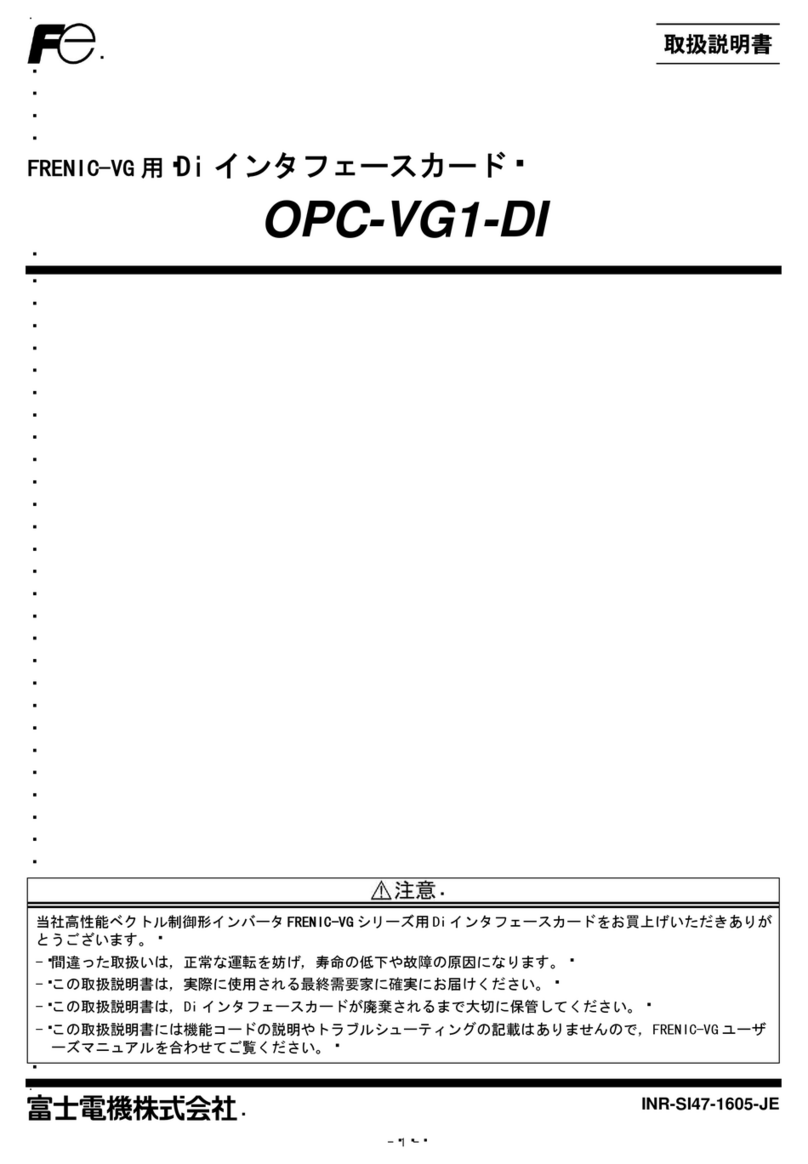
Fuji Electric
Fuji Electric OPC-VG1-DI User manual

Fuji Electric
Fuji Electric OPC-VG1-CCL User manual

Fuji Electric
Fuji Electric OPC-E1-CCL User manual
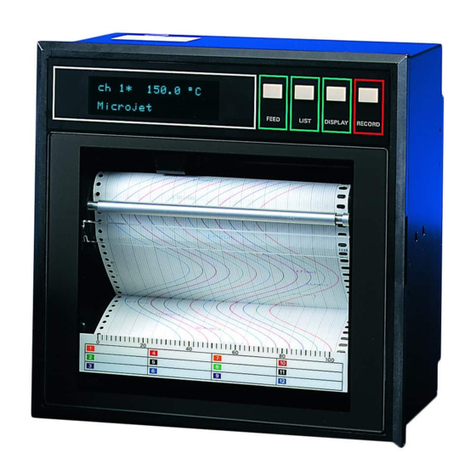
Fuji Electric
Fuji Electric PHA User manual
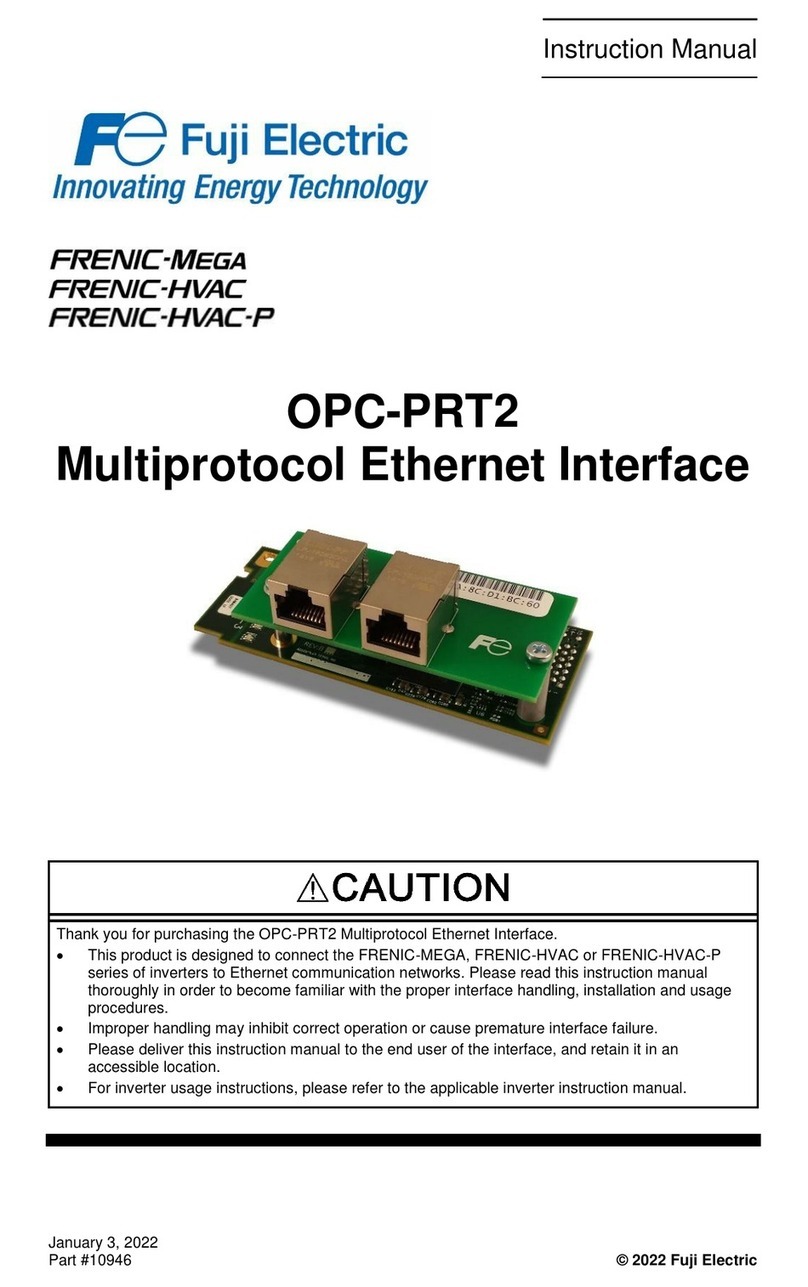
Fuji Electric
Fuji Electric OPC-PRT2 User manual

Fuji Electric
Fuji Electric OPC-VG1-PG User manual
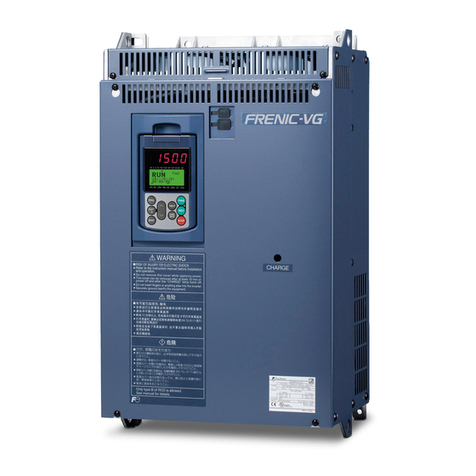
Fuji Electric
Fuji Electric OPC-VG1-TL User manual

Fuji Electric
Fuji Electric OPC-PRT User manual
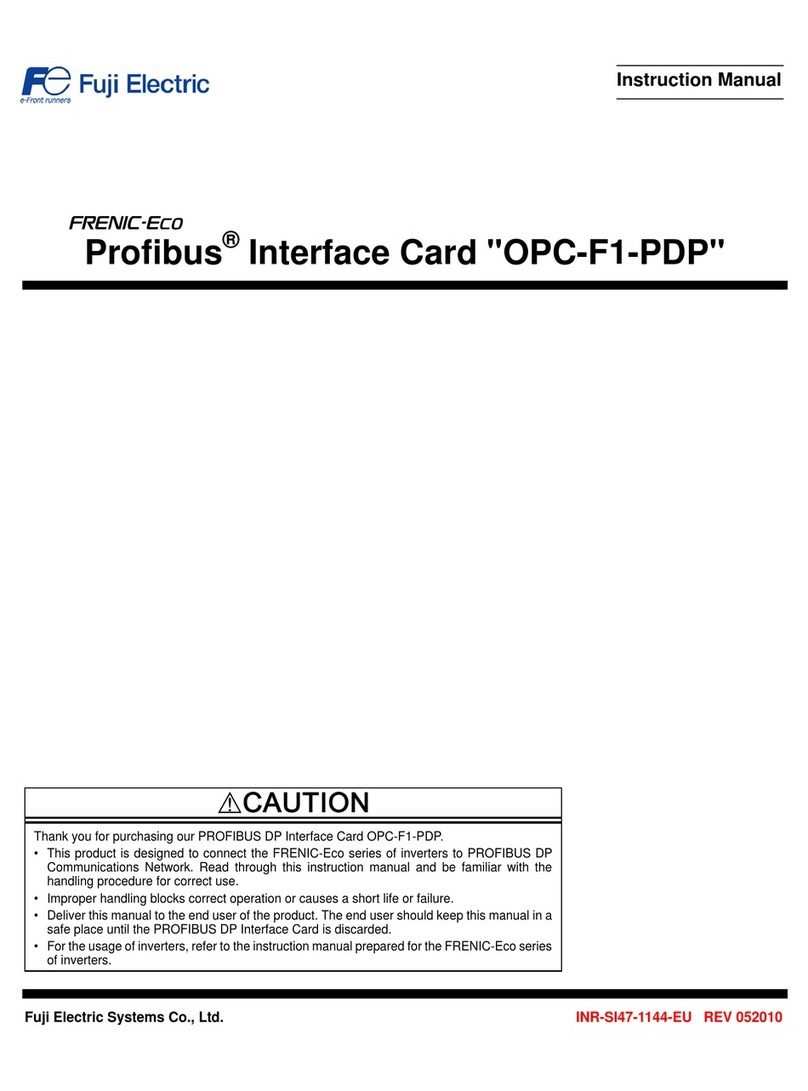
Fuji Electric
Fuji Electric Profibus OPC-F1-PDP User manual


















